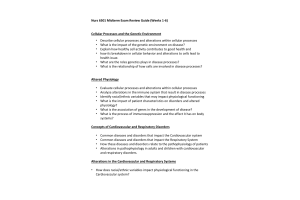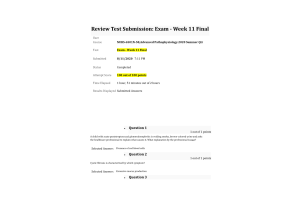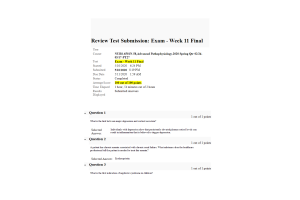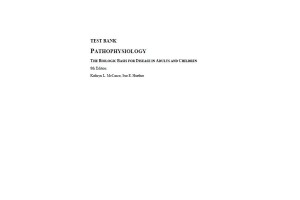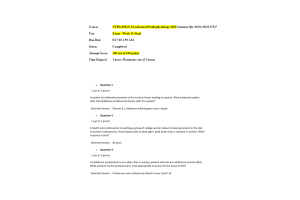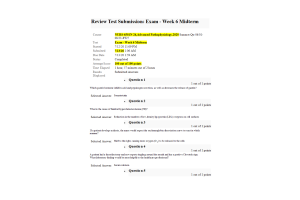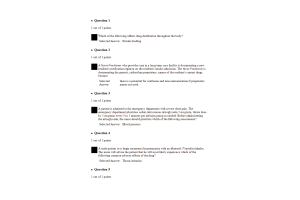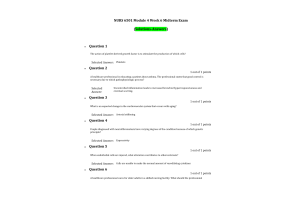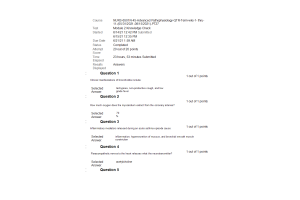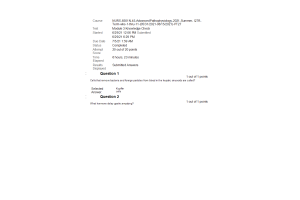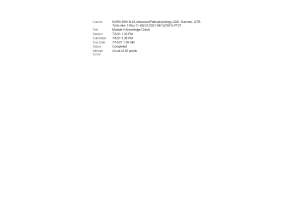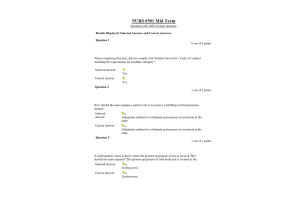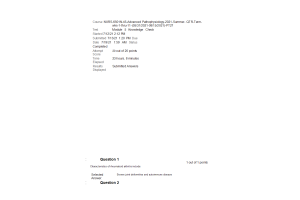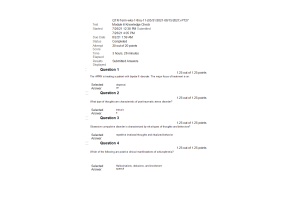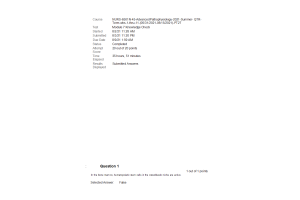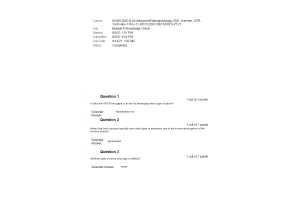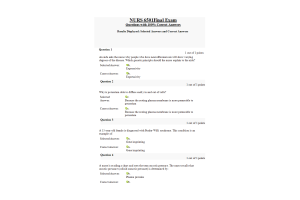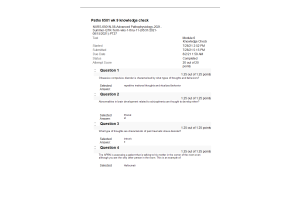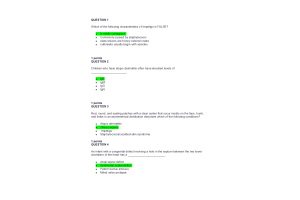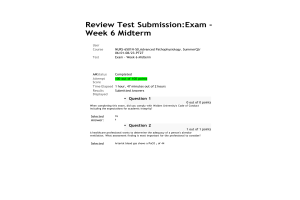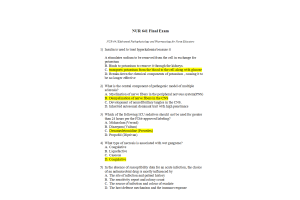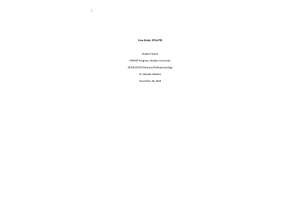NURS 6501N-32 Week 6 Midterm Exam100 out of 100 Points
- $49.00
NURS 6501 Advanced Pathophysiology
- Question: When endothelial cells are injured, what alteration contributes to atherosclerosis?
- Question: What does the healthcare professional tell the patient about this condition?
- Question: A patient has been admitted for a possible small intestinal obstruction. What is the first sign the healthcare professional assesses for that would indicate the presence of this condition?
- Question: Autocrine stimulation is the ability of cancer cells to do what?
- Question: A patient had a myocardial infarction that damaged the SA node, which is no longer functioning as the pacemaker of the heart. What heart rate would the healthcare provider expect the patient to have?
- Question: Which type of immunity is produced by an individual after either natural exposure to the antigen or after immunization against the antigen?
- Question: In teaching a women's community group, which risk factor does the healthcare professional teach is related to high morbidity of cancer of the colon, uterus, and kidney?
- Question: A student asks the healthcare professional to describe exotoxins. Which statement by the professional is best?
- Question: A student studying biology asks the professor to describe how the ras gene is involved in cancer proliferation. What explanation by the professor is best?
- Question: A healthcare professional cares for older adults in a skilled nursing facility. What should the professional assess for in these individuals related to cardiovascular functioning?
- Question: A healthcare professional is educating a patient on asthma. The professional tells the patient that the most successful treatment for chronic asthma begins with which action?
- Question: A healthcare professional is conducting community education on vaccinations. Which statement about vaccines does the professional include in the presentation?
- Question: Renal failure is the most common cause of which type of hyperparathyroidism?
- Question: Which renal change is found in older adults?
- Question: What is the single most common cause of cellular injury?
- Question: What organic compound facilitates transportation across cell membranes by acting as receptors, transport channels for electrolytes, and enzymes to drive active pumps?
- Question: In regulating vascular mediators released from mast cells, the role of eosinophils is to release what?
- Question: A patient in the clinic reports projectile vomiting without nausea or other gastrointestinal symptoms. What action by the healthcare professional is most appropriate?
- Question: What does vomiting-induced metabolic alkalosis cause?
- Question: A patient diagnosed with diabetic ketoacidosis (DKA) has the following laboratory values: arterial pH 7.20; serum glucose 500 mg/dL; positive urine glucose and ketones; serum potassium (K +) 2 mEq/L; serum sodium (Na +) 130 mEq/L. The patient reports that he has been sick with the flu for 1 week. What relationship do these values have to his insulin deficiency?
- Question: A student asks the professor how a faulty negative-feedback mechanism results in a hormonal imbalance. What response by the professor is best?
- Question: The acute inflammatory response is characterized by fever that is produced by the hypothalamus being affected by what?
- Question: A student asks the professor to differentiate Type 2 diabetes mellitus from Type 1. The professors' response would be that Type 2 is best described as what?
- Question: A student asks about the mechanism that results in type II hypersensitivity reactions. What description by the professor is best?
- Question: A healthcare professional is educating a patient about asthma. The professional states that good control is necessary due to which pathophysiologic process?
- Question: What is the role of the normal intestinal bacterial flora?
- Question: An amniocentesis indicates a neural tube defect when an increase in which protein is evident?
- Question: Oxygenated blood flows through which vessel?
- Question: A patient is having an IgE-mediated hypersensitivity reaction. What action by the healthcare professional is best?
- Question: Which normal physiologic change occurs in the aging pulmonary system?
- Question: A patient's chart indicates Kussmaul respirations. The student asks the healthcare professional what this is caused by. What response by the professional is most accurate?
- Question: A patient asks the healthcare professional why tissue damage occurs in acute rejection after organ transplantation. What response by the professional is best?
- Question: A patient asks the healthcare professional to describe the cause of gastroesophageal reflux disease (GERD). What response by the professional is best?
- Question: What is the inflammatory effect of nitric oxide (NO)?
- Question: A healthcare professional is caring for a patient undergoing chemotherapy. What is the skin-related health risk the professional should assess the patient for and be prepared to treat?
- Question: Which chamber of the heart endures the highest pressures?
- Question: A healthcare professional is caring for a patient who has continuous increases in left ventricular filing pressures. What disorder would the professional assess the patient for?
- Question: A healthcare professional is assessing a child whose parents report poor grades in school, trouble paying attention, and naughty behaviors that have become so frequent the child is always in trouble. For which health condition should the professional facilitate testing?
- Question: It has been determined that a patient's tumor is in stage 2. How does the healthcare professional describe this finding to the patient?
- Question: A professor has taught the students about the pathogenesis of abdominal pain. Which statement by a student indicates the professor needs to review the material?
- Question: A patient has a peptic ulcer related to h. pylori bacteria. What treatment does the healthcare professional educate the patient on?
- Question: What effect is a result of inhibiting the parasympathetic nervous system with a drug such as atropine?
- Question: A student is preparing to irrigate a patient's wound and gathers supplies, including hydrogen peroxide. What response by the health care professional is best?
- Question: Which cardiac chambers have the thinnest wall and why?
- Question: Free radicals play a major role in the initiation and progression of which diseases?
- Question: A student asks why carbon monoxide causes tissue damage. What response by the professor is best?
- Question: The glomerular filtration rate is directly related to which factor?
- Question: What is one function of the tumor cell marker?
- Question: A patient has a pulmonary capillary wedge pressure of 30mmHg. What assessment finding by the healthcare professional would be most consistent with this reading?
- Question: A patient is in severe shock and is receiving vasopressin. A student asks the health care professional to explain the rationale for this treatment. What response by the professional is most accurate?
- Question: What are blood pressure variations associated with?
- Question: A person wants to know if eating only plant-based foods is advisable as a way to cut cholesterol to near-zero levels. What response by the health care professional is best?
- Question: A student asks why some vaccinations are given orally and some are given by injection. What response by the professor is best?
- Question: A healthcare professional is working with a person who drinks several 6-packs of beer a week. What testing does the professional encourage the person to get?
- Question: Within a physiologic range, what does an increase in left ventricular end-diastolic volume (preload) result in?
- Question: People diagnosed with neurofibromatosis have varying degrees of the condition because of which genetic principle?
- Question: The data reporting that sickle cell disease affects approximately 1 in 600 American blacks is an example of which concept?
- Question: A person has hypothyroidism. What chemical does the healthcare professional advise the person to include in the diet?
- Question: A patient has been diagnosed with a renal stone. Based on knowledge of common stone types, what self-care measure does the healthcare professional plan to teach the patient when stone analysis has returned?
- Question: A professor has taught a student about skeletal alterations seen in chronic kidney disease. Which statement by the student indicates the professor needs to give more information?
- Question: What pathologic change occurs to the kidney's glomeruli as a result of hypertension?
- Question: A professor has taught the students about the sources of increased ammonia in patients with hepatic encephalopathy. What statement by a student indicates the professor should review this material?
- Question: What physical sign does the healthcare professional relate to the result of turbulent blood flow through a vessel?
- Question: A student asks the professor how a faulty negative-feedback mechanism results in a hormonal imbalance. What response by the professor is best?
- Question: A class of students has learned about contributing factors to duodenal ulcers. What statement indicates to the professor that the students need a review?
- Question: A class of students has learned about contributing factors to duodenal ulcers. What statement indicates to the professor that the students need a review?
- Question: What part of the kidney controls renal blood flow, glomerular filtration, and renin secretion?
- Question: A patient has been diagnosed with primary emphysema but claims there is no history of smoking. What action by the healthcare professional is most appropriate?
- Question: The student asks the professor to explain what characteristic is demonstrated by lungs with decreased compliance?
- Question: The student wants information about a patient's renal function. What test does the healthcare professional tell the student to evaluate?
- Question: Which hormone is required for water to be reabsorbed in the distal tubule and collecting duct?
- Question: When comparing the clinical manifestations of both diabetic ketoacidosis (DKA) and hyperglycemic hyperosmolar nonketotic syndrome (HHNKS), which condition is associated with only DKA?
- Question: A patient had a thyroidectomy and now reports tingling around the mouth and has a positive Chvostek sign. What laboratory finding would be most helpful to the healthcare professional?
- Question: A parent wants to know how to prevent type 1 diabetes in the newborn. The healthcare professional explains that prevention is not possible, because which of these is a major characteristic of type 1 diabetes mellitus?
- Question: A student asks the healthcare professional to explain the function of the papillary muscles. What response by the professional is best?
- Question: The Bainbridge reflex is thought to be initiated by sensory neurons in which cardiac location?
- Question: A healthcare professional is caring for four patients. Which patient does the professional assess for neurogenic diabetes insipidus (DI)?
- Question: A patient suffered multiple traumatic injuries and received many blood transfusions within a few days of the injuries. For which medical condition should the healthcare professional monitor the patient for?
- Question: A patient has portal hypertension-induced splenomegaly. Which lab value would the healthcare professional associate with this condition?
- Question: A healthcare professional tells a student that a patient has lost atrial kick. What would the student expect to see when examining this patient?
- Question: Which primary characteristic is unique for the immune response?
- Question: Why is leakage of lysosomal enzymes during chemical injuries significant?
- Question: A healthcare provider notes that tapping the patient's facial nerve leads to lip twitching. What electrolyte value is correlated with this finding?
- Question: What are tumor cell markers?
- Question: A Rh-negative woman gave birth to a Rh-positive baby. When discussing Rho[D] immunoglobulin with her, what information should the healthcare professional provide?
- Question: If a patient develops acidosis, the nurse would expect the oxyhemoglobin dissociation curve to react in which manner?
- Question: What is the role of reverse transcriptase in HIV infection?
- Question: During acidosis, the body compensates for the increase in serum hydrogen ions by shifting hydrogen ions into the cell in exchange for which electrolyte?
- Question: A female patient has been diagnosed with an uncomplicated urinary tract infection. What self-care measure does the healthcare provider teach the patient that is specific to this type of infection?
- Question: During the cardiac cycle, why do the aortic and pulmonic valves close after the ventricles relax?
- Question: What is the blood type of a person who is heterozygous, having A and B alleles as codominant?
- Question: Where is two thirds of the body's water found?
- Question: The student asks the professor why water and electrolytes are transported in both directions through tight junctions and intercellular spaces rather than across cell membranes. What response by the professor is best?
- Question: A healthcare professional is assessing a child who has complete trisomy of the twenty-first chromosome. What findings does the professional relate to this condition?
- Question: A patient had a motor vehicle crash and suffered critical injuries to the brainstem. What physiological responses would the healthcare professional expect to see?
- Question: How do free radicals cause cell damage?
- Question: What is the only surface inside the nephron where cells are covered with microvilli to increase the reabsorptive surface area called?
- Question: What causes the edema that occurs during the inflammatory process?
- Question: After a partial gastrectomy, gastric bypass, or pyloroplasty, clinical manifestations that include increased pulse, hypotension, weakness, pallor, sweating, and dizziness are the results of which mechanism?
- Question: A patient has a history of excessive use of magnesium-containing antacids and aluminum-containing antacids. What lab value does the healthcare professional correlate to this behavior?

